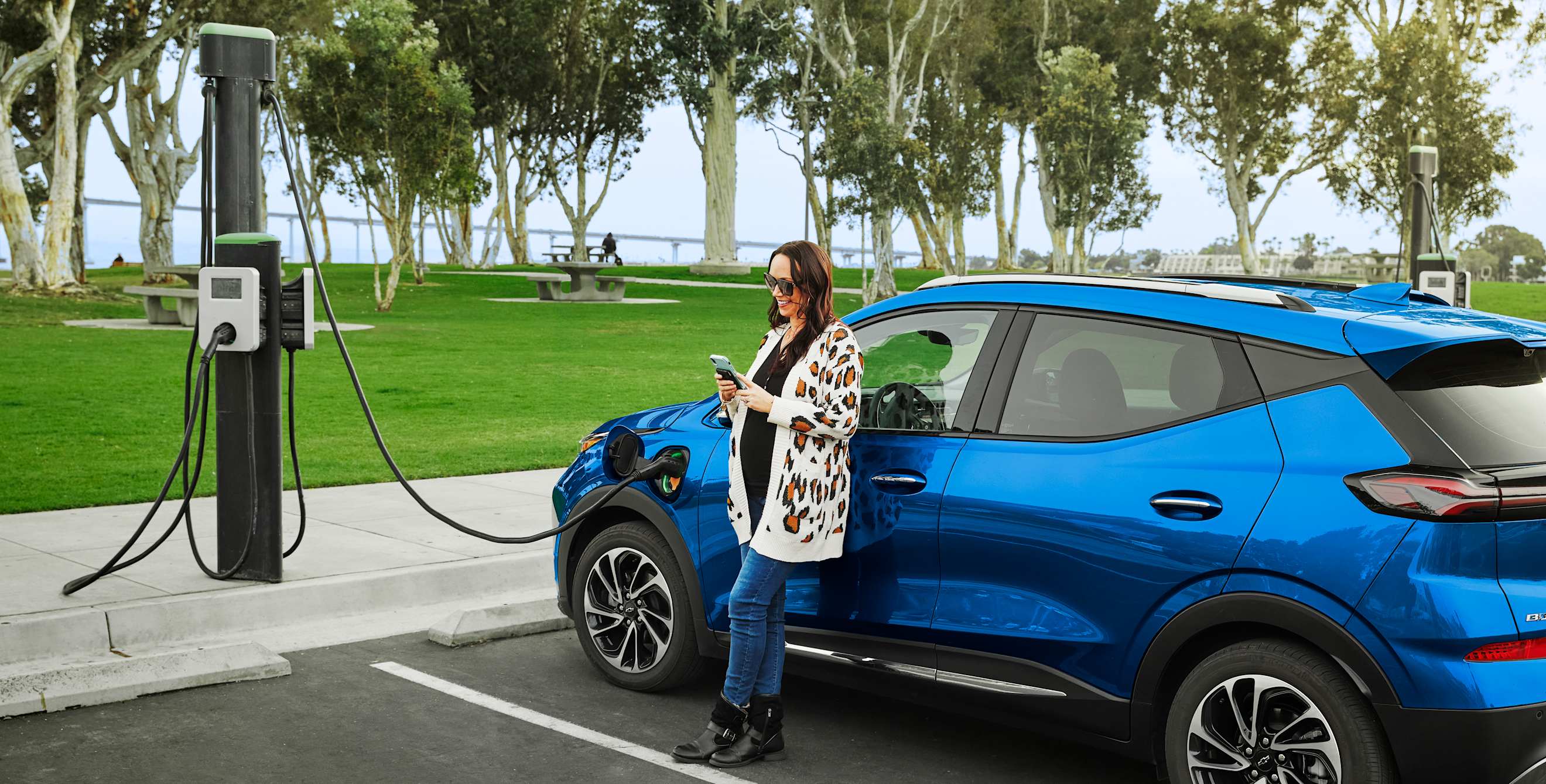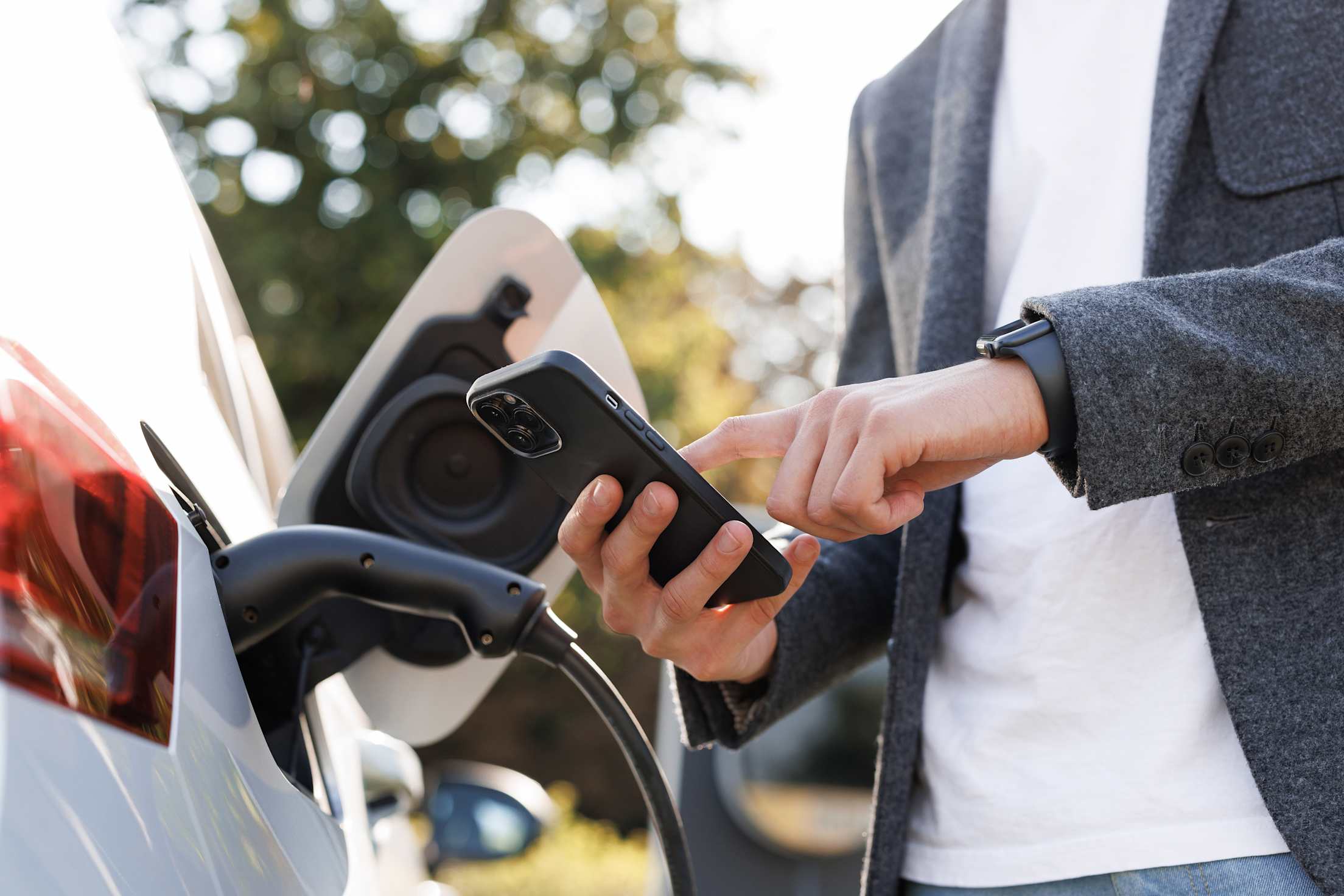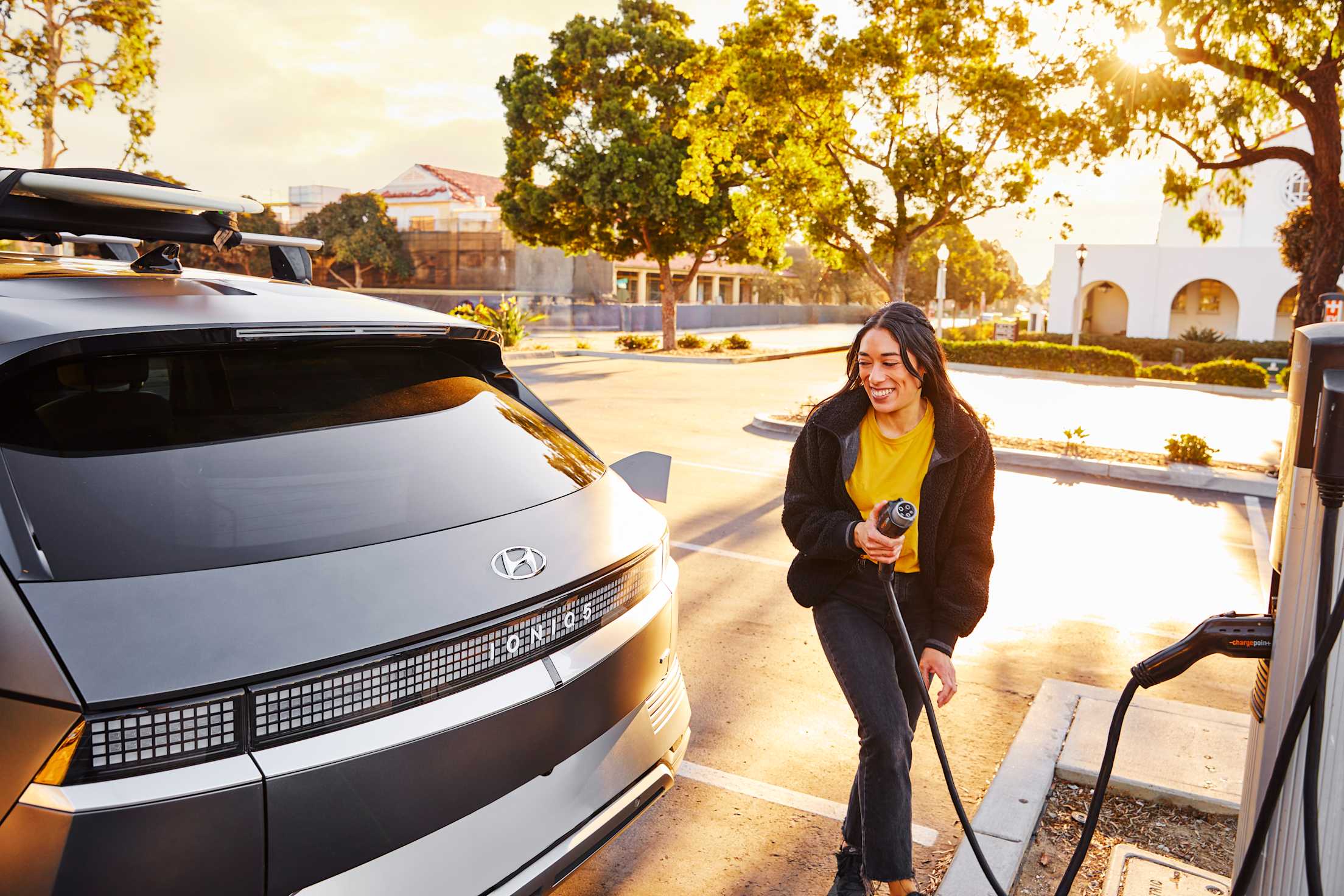
How to Get the Best Price at Public EV Charging Stations
Save money when you’re on the road and need a charge.

An electric vehicle (EV) can save you money by swapping gas for electricity. While you don’t need to contend with rising gas prices—paying an average of $3.12 a gallon—you still need to charge your car. Current AAA data shows that EV charging prices are an average of 34 cents per kilowatt-hour at public charging stations.
Eighty percent of EV charging occurs at home, but a quarter of Americans don’t have access to private chargers where they live, according to the U.S. Department of Energy. And then there are those other times when you need to charge your car away from home. To save money, here’s how to get the best prices at public EV charging stations.
1. Find a free EV charging station.
The most cost-effective solution is finding free EV charging stations in your area using an app like PlugShare.
“For locating a charging station nearby, PlugShare is the most popular app. It also gives you an idea of the station’s reliability,” says Jon Vorisek, founder and CEO of Repair Surge, which provides repair and maintenance information for EVs and other vehicles.
You can typically find free charging at certain retailers like Cinemark movie theaters, Macy’s, and supermarkets. Additionally, public places such as your local library and city hall may offer free charging. Check with your employer as well, since some companies offer free EV charging as a perk for employees.
The downside of free charging is the time commitment. Typically free chargers are Level 2, which gives you up to 20 miles of range after charging your EV for an hour. A Level 3 or direct current fast charging (DCFC) can give you a full charge in half the time. Additionally, you may have to fight over space in a crowded parking garage. What you save in money, you pay for in time.
2. Understand how pricing works.
Not all EV charging stations have the same pricing structure. Understanding the key differences in pricing can help you make an informed decision on where to go.
“While every U.S. gas station charges for fuel by the gallon, public EV charging stations use a variety of pricing methods. Public EV charging is often billed at per-minute or per-hour rates that may be tiered based on the power consumption rate,” says Greg Brannon, director of automotive engineering at AAA.
Some factors that can impact the cost of charging your EV include:
- Charging station pricing structure. You could pay based on the electricity you use while charging, expressed as kilowatt-hours (kWh), or the time spent charging.
- Type of connector. The type of connector you have determines what level of charge you can get, which impacts costs. A J1772 connector works for Level 1 and 2 chargers, while Level 3 uses a CCS connector, CHAdeMO connector, or Tesla connector.
- Membership fee. You may pay a membership fee with certain networks, which can discount the per-hour rate.
- Battery capacity. EV owners with a higher battery capacity may have to pay for more electricity to get a full charge.
- Available time. If you have limited time but need a big charge, you’ll pay more for faster service.

3. Use apps to compare costs.
From 2020 to 2024, public EV charging stations in the U.S. more than doubled, according to the Department of Energy. The surge in availability is a boon for electric vehicle owners who now have more options than ever. To get the best deal, compare costs on a mobile app or website.
“Each charging station usually has its own app, and those will give you the most accurate information about availability. Plus, you can pay through the app. That’s a convenience and sometimes a necessity when the card readers at the station aren’t working,” says Vorisek.
Some chargers belong to specific charging networks and have their own apps. You can compare prices at local chargers through their apps, including:
You can also use third-party apps such as ChargeHub and PlugShare to check out pricing information for nearby chargers. Free charging stations may require you to download an app, but it depends on the vendor.
Make sure to factor in any potential session or membership fees as part of your costs. Some memberships offer charging discounts, which could make the fee worth it depending on how frequently you charge your vehicle.
4. Avoid idle fees.
It’s convenient to charge your car while you run an errand or go shopping. But if you’re not back when the charge is up, you could be hit with an idle fee. According to Tesla, idle fees occur when a Supercharger station is at 50% capacity or more. You have a five-minute grace period. But after that, expect an idle fee. More importantly, be aware that when the station is at 100% capacity, idle fees double.
Other stations may have similar policies. Your best bet is to move your vehicle once it’s done charging. If you’re multitasking, set an alarm so you know when to return to avoid extra fees.

5. Charge off-peak.
You could be paying more when you charge your EV during peak hours.
“You can save money at some charging stations by using them during off-peak hours, usually late at night,” says Vorisek.
Finding charging stations that aren’t busy or going after peak hours can be a solid savings strategy, particularly for Tesla owners. Some Superchargers have dynamic pricing, which increases the cost during peak hours.
6. Take it slow.
Another way to reduce costs is to opt for a slower charge—whenever possible, use a Level 2 charger instead of Level 3.
According to DriveClean from the California Air Resources Board, fully charging a Nissan Leaf with a 150-mile range and 40-kWh battery would cost $12 with Level 2 versus $16 with DCFC.
But that may be only practical for top-offs. According to the U.S. Department of Transportation, the estimated time for a light-duty battery electric vehicle (BEV) to charge from empty is four to 10 hours with Level 2, compared with 20 minutes to one hour with Level 3 or DCFC.
(Note: The same go-slow advice applies to driving. You can get more out of each charge if you slow down on the road. Of course, you want to drive the speed limit. But rapid acceleration uses more electricity, not to mention being dangerous.)
7. Book hotels with free charging for road trips.
You can still go on road trips with an electric vehicle, it just requires some planning ahead. “AAA TripTik allows you to plan your trip with stops for charging and easily find EV charging stations and their pricing,” says Brannon.
Other resources like A Better Routeplanner (ABRP) or the Alternative Fueling Station Locator from the Department of Energy can also help.
When you’re between destinations and need to stay overnight, you can reduce costs by booking hotels with free EV charging stations. For example, Booking.com has a filter for “Electric vehicle charging station” under amenities when researching hotels. Once you identify your options, you can compare them with other charging apps. Beware of potential parking costs that can eat into your savings.
Make smart choices, whether you’re buying, selling, insuring, maintaining, or repairing a vehicle.